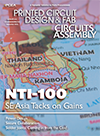Products
This no-drip, Pb-free, no-clean SAC 305 solder paste for mechanical soldering is said to be excellent for gap filling and application on vertical surfaces. Help solder joints around a heat tube (or heat sink) container. Reportedly wets well and wicks around many metal surfaces like silver, silver-plated, nickel, brass, and copper.
EFD Inc., www.efd-inc.com
SIP and STRIP male pin headers feature sturdy 0.040" diameter leads; mate to standard SIP and STRIP female sockets. The double-row connector is offered standard in 8 (2x4) up to 100 (2x50) position configurations on 0.100" spacing. Reportedly creates a high current interconnect rated at 8 amps per position. The low-profile insulator (0.071" thick) is manufactured with high-temperature thermoplastic. Standard and RoHS plating available. Use brass alloy 360 ½ hard.
Mill-max, www.mill-max.com
Hysol FP4581 and FP4583 are liquid epoxy encapsulants for use as underfills for flip-chip devices. FP4581 is formulated high-lead, bumped large die flip-chip packages. Is said to have low coefficient of thermal expansion properties and improved toughness over previous materials; forms a rigid, low-stress seal on solder joints. Is said to be ideal for flip-chip devices that require improved crack and fracture resistance. Is compatible with most no-clean flux systems. FP4583 is for applications requiring a fine filler. Contains fillers less than or equal to 2 µm in diameter; is formulated for overmolded components.
Henkel Corp., www.henkel.com/electronics
The YTV B3 benchtop AOI now comes standard with Fusion Lighting. Said to offer up to 3x improvement in inspection speed and advanced image processing. Consists of more than 600 colored LED lights that project to the PCB surface from different angles (high, medium and low). Enhanced contrast in the image is said to allow inspection algorithms to identify features in component body or solder joints that would have been previously difficult to see. Is available with two top-down viewing thin cameras for inspection of components down to 01005s. Cameras reportedly permit small component inspection without a significant increase in cycle times.
YESTech, www.yestechinc.com
Pyramax 100 reflow oven comes in 8-zone air or nitrogen models, and recaches 350ºC maximum temperature. Is Pb-free capable, reportedly has low nitrogen and power consumption, and uses closed loop convection control. Delivers features like side-to-side recirculation, and convection efficiency that reportedly reduces zone temperature set points. Features Windows-based Wincon oven control software and smart-tracking SMEMA conveyors.
BTU International Inc., www.btu.com
StatNot XC is a static dissipative material that can be combined with existing materials, such as the NP510A fiberglass epoxy composite. The composite surface is said to maintain a surface resistivity of 106 to 109 ohms per sq. Said to be ideal for applications in the electronics assembly market, such as test fixtures and assembly work surfaces. Is tested and certified to a surface resistivity range of 105 to 1010 ohms per sq.
Norplex-Micarta, www.norplex-micarta.com
Press Releases
- Innominds and SIIX launch SIIX-Innominds JV to offer full-stack ODM services in India
- Syrma SGS Technology, Ltd to Accelerate AI-Driven Manufacturing with implementation of analytics and AI solution from Arch Systems in partnership with NMTronics India
- TTCI and The Training Connection Strengthen Electronics Manufacturing with Test Services and Training at PCB West 2025
- SMTA “Members of Distinction” Awards Announced


